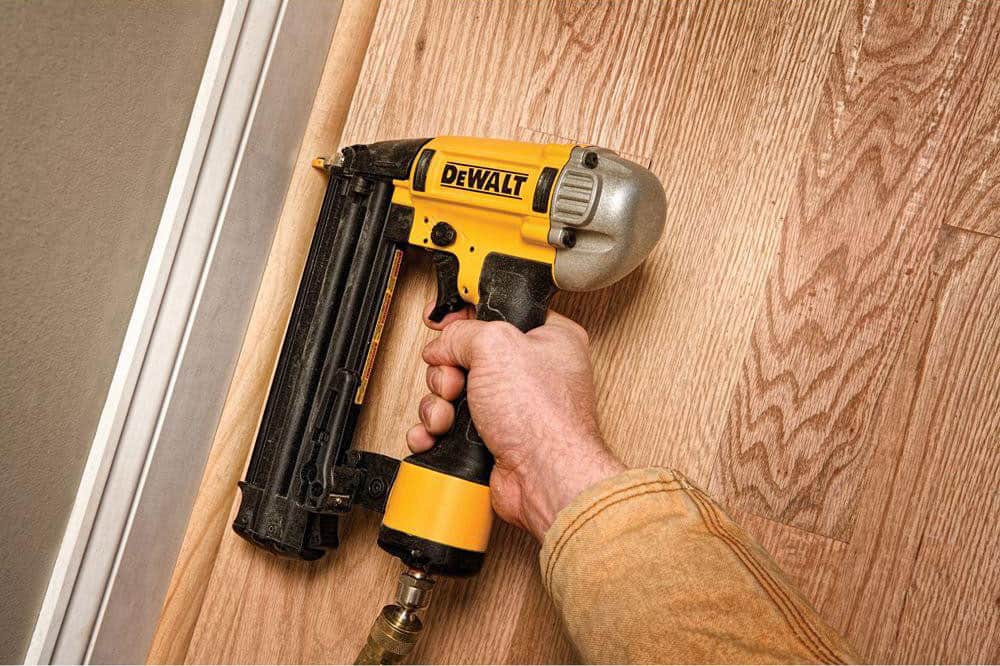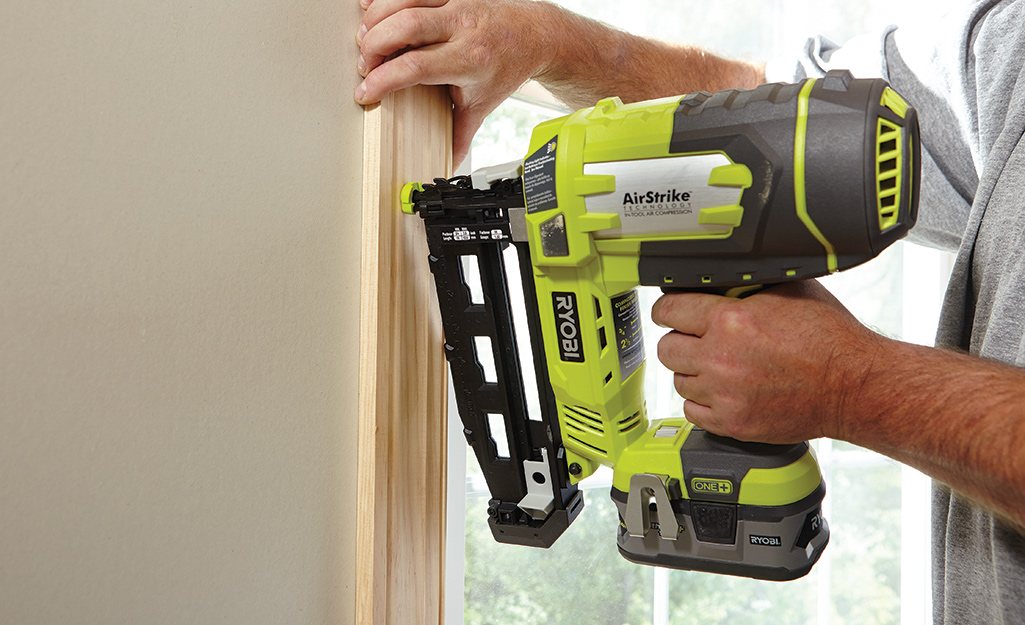So, you’re looking to take on a DIY project and wondering what size nail gun to use for door trim? Well, you’ve come to the right place! Choosing the right nail gun can make a huge difference in the success of your project. But don’t worry, I’ve got you covered with all the information you need.
Now, when it comes to door trim, the size of the nail gun depends on the thickness and material of the trim. You want to make sure that the nails are long enough to securely hold the trim in place without going through the other side. Using nails that are too short can lead to loose and unstable trim, while nails that are too long can cause damage.
So, let’s dive in and explore the different nail gun sizes suitable for door trim. With the right tool in your hand, you’ll be able to tackle your project like a pro in no time!
Choosing the Right Size Nail Gun for Door Trim
When it comes to door trim, finding the right nail gun size is essential for achieving professional results. Here’s a simple guide to help you:
- Measure the thickness of your door trim.
- Determine the nail size required for your trim thickness.
- Choose a nail gun that can handle the nail size needed.
- Consider additional features like adjustable depth settings for precision.
- Ensure the nail gun is compatible with your air compressor or power source.
By following these steps, you’ll have a nail gun that’s perfectly suited for your door trim project.

What Size Nail Gun is Best for Door Trim?
If you’re looking to tackle a door trim installation project, one of the most important decisions you’ll have to make is choosing the right size nail gun. The size of the nail gun can greatly impact the effectiveness and efficiency of your work. In this article, we’ll explore the different sizes of nail guns available and help you determine the best size nail gun for door trim installation. Whether you’re a DIY enthusiast or a professional contractor, this guide will provide you with valuable insights to make an informed decision.
The Importance of Choosing the Right Size Nail Gun
When it comes to installing door trim, using the appropriate nail gun size is crucial. Using a nail gun that is too large or too small can result in a variety of issues. A nail gun that is too large may cause damage to the trim or even split the wood, while a nail gun that is too small may not provide enough holding power, leading to loose or unstable trim.
The size of the nail gun refers to its gauge, or the thickness of the nails it can accommodate. The most common sizes for nail guns used in door trim installation are 15 gauge and 18 gauge. Each size has its own advantages and considerations, so let’s dive into the details.
15 Gauge Nail Gun
A 15 gauge nail gun is a versatile option that is commonly used for door trim installation. The 15 gauge nails are thicker and longer compared to those used in the 18 gauge nail gun. This results in a stronger hold, making it suitable for heavier and thicker trim materials. The nails also have a larger diameter, reducing the risk of splitting the wood.
One of the main benefits of using a 15 gauge nail gun is its ability to withstand the test of time. The strong hold provided by the thicker nails ensures that the trim remains securely in place, even with wear and tear over time. Additionally, the larger nails have a higher holding capacity, reducing the likelihood of the trim coming loose due to temperature changes or structural movement.
However, it’s important to note that 15 gauge nail guns are generally larger and heavier compared to the 18 gauge options. This can make them slightly more difficult to maneuver, especially in tight spaces or when working overhead. It’s also worth considering that 15 gauge nails leave a larger hole, which may require more extensive filling and touch-up work.
18 Gauge Nail Gun
The 18 gauge nail gun is another popular choice for door trim installation. These guns use smaller and thinner nails, resulting in smaller holes and a more discreet finish. The smaller gauge also makes the gun lighter and easier to handle, particularly in tight or hard-to-reach areas.
While the 18 gauge nail gun may not provide the same level of holding power as the 15 gauge option, it is still suitable for most door trim applications. It offers enough strength to secure the trim, especially with the help of an adhesive or wood glue. The smaller nails also make it easier to conceal the nail holes, requiring less filling and touch-up work.
It’s important to note that the holding power of the 18 gauge nails may not be ideal for very heavy or thick trim materials. Additionally, the smaller nails may be more prone to bending or breaking if subjected to excessive force or pressure.
Factors to Consider when Choosing the Size Nail Gun
Now that we’ve explored the differences between the 15 gauge and 18 gauge nail guns, it’s important to consider a few additional factors before making your final decision:
Material and Thickness of the Trim:
The material and thickness of the door trim should be taken into account when choosing the size nail gun. Heavier or thicker materials may require the stronger hold provided by a 15 gauge nail gun. Conversely, lighter or thinner trim materials may be suitable for an 18 gauge nail gun.
Work Environment:
The work environment can also impact the size nail gun you choose. If you’ll be working in tight spaces or overhead, maneuverability and weight may be important considerations. In such cases, an 18 gauge nail gun may be more suitable due to its smaller size and lighter weight.
Preference:
Ultimately, personal preference plays a role in the decision-making process. Some professionals and DIY enthusiasts may have a personal preference for one size over the other based on their experience, comfort, or desired finish. It’s important to choose a size that you feel confident and comfortable working with.
Key Takeaways: What Size Nail Gun for Door Trim?
- A nail gun with an 18-gauge or 15-gauge finish nail is ideal for door trim.
- Consider the thickness of the door trim when choosing the nail size.
- An 18-gauge nail gun is suitable for lighter door trims, while a 15-gauge nail gun is better for thicker trims.
- Using the right size nail gun helps prevent damage to the trim and ensures a secure installation.
- Always follow the manufacturer’s recommendations and guidelines for the specific nail gun model.
Frequently Asked Questions
When it comes to door trim, choosing the right nail gun size can greatly impact the outcome of your project. Here are some common questions and answers to help you determine what size nail gun you should use:
1. What factors should I consider when choosing a nail gun for door trim?
When selecting a nail gun for door trim, consider the type and thickness of the trim material. If you’re working with hardwood trim, you’ll need a more powerful nail gun than if you’re using softer materials like MDF. Additionally, consider the size and style of nails you’ll be using, as different nail guns accommodate different nail sizes.
Also factor in the project’s scale and your level of experience. If you’re working on a large-scale trim project or are a professional contractor, a more heavy-duty nail gun may be necessary. For smaller projects or beginners, a lighter, more user-friendly nail gun could be a better fit.
2. What size nail gun should I use for standard door trim?
For standard door trim, a 15 or 16 gauge nail gun is usually suitable. These sizes are ideal for securing door trim without causing any splitting or damage. A 15 gauge nail gun offers more holding power, while a 16 gauge nail gun is slightly smaller and produces smaller nail holes.
Ultimately, the choice between a 15 and 16 gauge nail gun depends on personal preference and the level of finishing desired. Both options can deliver excellent results, so it comes down to what you feel most comfortable using.
3. Can I use an 18 gauge nail gun for door trim?
While you can technically use an 18 gauge nail gun for door trim, it’s not the most recommended option. An 18 gauge nail gun is better suited for lighter trim materials such as baseboards, crown molding, or paneling. The smaller diameter of the nails produced by an 18 gauge nail gun may not provide the same level of stability as a 15 or 16 gauge nail gun when it comes to door trim.
If you choose to use an 18 gauge nail gun for door trim, be cautious and ensure that the nails are properly sized and adequately secure the trim in place.
4. Are there any safety precautions I should consider when using a nail gun for door trim?
Yes, there are a few safety precautions to keep in mind when using a nail gun for door trim. Always wear appropriate safety gear, including safety glasses and ear protection, to protect yourself from flying debris and loud noise.
Ensure that the work area is clear of any obstructions or hazards that could pose a tripping or falling risk. Additionally, take the time to read and understand the manufacturer’s instructions for operating the nail gun, including proper handling and maintenance procedures.
5. Can I rent a nail gun for my door trim project?
Yes, renting a nail gun can be a cost-effective option, especially if you don’t plan on using it frequently. Many home improvement stores offer nail gun rentals, allowing you to choose the right size and type of nail gun for your door trim project without having to make a long-term investment.
Be sure to ask the rental store for proper instructions and guidelines for using the specific nail gun you rent. Familiarize yourself with its features, safety mechanisms, and any additional accessories or attachments you may need along the way.

Summary
So, what size nail gun do you need for door trim? The answer is a 15 or 16-gauge nail gun. These sizes are perfect for attaching trim to doors because they provide enough holding power without splitting the wood. Additionally, using a nail gun with the right size nails can save you time and effort compared to using a hammer and nails. Remember to always wear safety goggles and follow the manufacturer’s instructions when using a nail gun.
In conclusion, when it comes to door trim, a 15 or 16-gauge nail gun is your best bet. It will help you securely attach the trim without causing any damage to the wood. Nail guns are convenient tools that can make your project much easier, but remember to prioritize safety and read the instructions before use. Happy trim installing!
